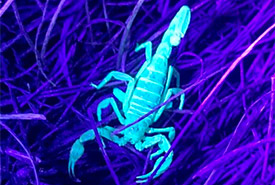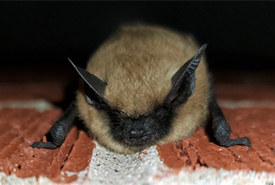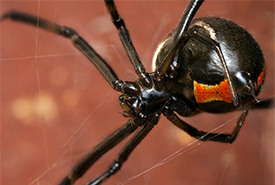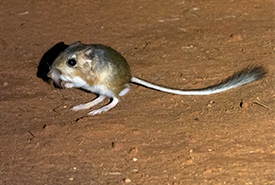Our Prairie Scaries
How seemingly scary grassland species are ecologically important
Northern Scorpion (Photo by Caleb Catto, CC-BY-4)
As Halloween approaches, our minds turn to the creatures that might send shivers down our spines: bats, snakes, spiders and more. But these animals become less frightening as their vital roles in Prairie grassland ecosystems are understood.
Bat brigade
Bats, with their fluttering flight and nocturnal habitats, are much maligned and misunderstood. While they might freak some people out, they play an essential role in prairie ecosystems. That’s because they are voracious predators of insects, including annoying mosquitoes and agricultural pests.

Western small-footed bat (Photo by Joey Kellner, CC BY NC)
Several bat species can be found across Canada’s Prairie grasslands. Some of these are generalists, with wide ranges and habitat preferences, while others are bit pickier. For example, western small-footed bats are live in prairie river valleys in Alberta and Saskatchewan that feature large cottonwood trees.
The truly frightening thing about Canada’s bats is that several are endangered due to white-nose syndrome, a fungal pathogen with a 90 per cent mortality rate. To help these important insectivores, bats were recently protected under the Alberta Wildlife Act, meaning it is now illegal to kill them without a permit.
Glowing in the dark
Who would have thought that Canada's grasslands are home to scorpions? The northern scorpion, found in southern parts of Alberta and Saskatchewan, is the only scorpion species found in Canada. The exoskeleton of these nocturnal insect predators fluoresces under UV light, creating an otherworldly blue-green glow. Using one of these lights at night is how researchers typically find them! Despite its intimidating appearance, its sting is said to be no worse than that of a bee or wasp. They have a soft side too — by engaging in intricate courtship rituals and providing maternal care for their young.
Enjoying this story? Sign up for our newsletter!
Spooky spinners
With its characteristic red hourglass mark (on females), the western black widow spider seems like a Halloween decoration come to life.

Western black widow (Photo by Bobb Lalonde, CC-BY-NC)
However, this venomous arachnid, found in the prairie provinces, plays an important role as an insect predator. The black widow's messy-looking web is not for decoration but is rather a masterful tool for capturing its insect prey. While these spiders are infamous for their neurotoxic venom, their bite rarely poses a serious threat to adults.
Prairie rattlesnakes
The sight of a rattlesnake might send some running, but they're far from the monsters of horror tales. Prairie rattlesnakes, found in southeastern Alberta and southwestern Saskatchewan, play an important role in prairie ecosystems as efficient predators of rodents, helping to control their populations.
A species at risk, prairie rattlesnakes congregate to hibernate each winter at sites known as hibernacula. These are typically crevasses among rocks, abandoned rodent burrows, or other underground nooks and crannies. These sites are used year after year and are critical to the rattlesnake’s survival over the frosty winter months.
While prairie rattlesnakes are venomous, their bite is rarely deadly to people, and they usually only strike as a defensive last resort. And when approached, they usually let their presence be known by shaking their namesake rattle. So, if you ever see one, give it space and you will be fine!
Bobcats
Most bobcats feature beautiful spotted coats, but on rare occasions, melanistic bobcats can be seen to have a Halloween-like jet-black coat. Bobcats are found throughout a diversity of habitats, including grasslands. Researchers studying these cats have found that they typically use river valleys within prairie ecosystems to travel long distances. While they might be elusive, they play a vital role in controlling populations of prey species, such as rabbits and rodents.
Ord's kangaroo rat
Not a true rat, this small mammal is far from frightening. In fact, it is ridiculously cute.

Ord's kangaroo rat (Photo by Joshua Wade Covill, CC-BY-NC)
An endangered species in Canada, Ord’s kangaroo rat is found in sandy areas, particularly dunes, in southeastern Alberta and southwestern Saskatchewan. Beyond being adorable, kangaroo rats play a crucial role in prairie ecosystems by dispersing seeds and creating underground habitats by burrowing.
Not so scary after all?
This Halloween, let’s remember our prairie scaries aren’t the frightening creatures in our scariest stories. Bats, black widows, scorpions, rattlesnakes, bobcats and kangaroo rats all contribute to the health of our prairie grasslands. So maybe they’re not so scary after all?
Want to help our prairie scaries? Support the Prairie Grasslands Action Plan!




